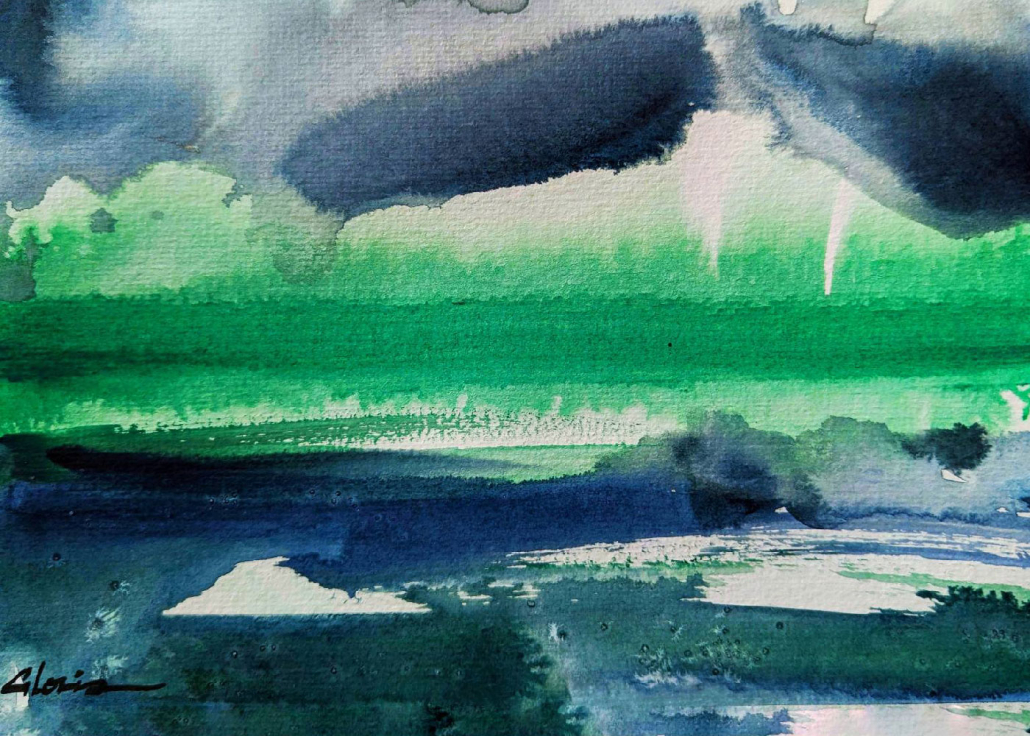Image: ‘Psalm 90’ by Gloria Liang, watercolour, 2023.
‘A musical Way’
Andrew Collis
Ordinary Sunday 30, Year A
Psalm 90; Matthew 22:34-46
We can think about mission in terms of our mission statement (key words: open, creation, dare, share, seek) … in terms of a mission structure to our life and work (and website) – an underlying mission theme: congregation-community-garden (crossing back and forth, translating) … in terms of a mission motto: we pray, we serve, we grow … or mission stories bearing witness to God’s presence and promise in South Sydney.
We can think about mission, the missio dei, God’s love for the world, in a musical way.
Country music songwriters refer to “three chords and the truth” – a simple model built upon the first, fourth and fifth chords in a given key – infinite possibilities for expression, improvisation, transformation.
Three chords and the truth … three chords, one song … the mystic song of God … trinitarian, cross-cultural, philosophical … celebratory, ceremonial, sacramental, anarchic, melancholic, meandering, querying, queering, wondrous, joyous … meditative, collaborative …
The mission of God, in other words, is movement, and moves us … from here to there, from individuation/isolation to community, from addiction/idolatry to freedom.
Whether we think about ancient songlines, folk or pop tunes, blues, punk, hip-hop … birdsong or the sound of wind in the trees … the cosmic music of the spheres … the parables, psalms or songs of the heart … we can relate. The missio dei resonates. God’s love for the world reverberates.
In the key of C, the I chord is C (let’s say C for Creation). It is the root or tonic, the tonal centre. We feel at home here – sometimes comfortably, sometimes awkwardly – content, sad, tired, restless, angry …
A simple song moves to the IV chord, in this case the F (let’s say F for Faces – human and non-human, visible and invisible). The IV chord may stretch us. It may carry us far from home – across the universe, to unfamiliar life-worlds – to strange embodiments of the divine. The IV chord may also mark a crisis … a critical encounter with authority, history or reality. The IV chord – the face of Jesus and friends – may register a cry of ecstasy or distress, calling (us) out … in the name of the Unconditional: justice, friendship, hospitality …
Then, there’s the V chord, the G (let’s say G for Goodness). The V chord (present at any point in the progression) invites return – respect, repentance, renewal – home again … to ourselves, to our true selves, to Creation … as though for the first time.
The song, punctuated by silence – shorter or longer periods of rest – spirals on … “hosting an alternative imagination of matter, an alternative imagination of the sacred, and an alternative imagination of the social, an other atmosphere” (J. Kameron Carter).
Major and minor chords, inverted and augmented … multiple modes, various moods, time signatures and dynamics … shape the song. I try to understand this. I play along … tune in, join in … listen, listen, listen (as spiritual carers advise) … to the truth of what is sung … that I, too, might sing – not just for myself (private devotions), but for/of/in the world beloved and broken (that I might sing a love of God and neighbour).
The missio dei, like music, offers space for healing – invites change, brings wisdom and grace.
As a visual representation of mission as music, we might make use of our triangle cut-outs, marking each corner with a C, F and G, then thinking about Creation, Faces and Goodness … Creator/Creativity, Face/Fingers/Fringe/Frame, Grace/Good Spirit … however we hear the mystic song … Is there something you might draw or write within such a triangle – within the space of the song? Is there a lyrical idea you’d like to explore? A symbol or picture … question or emotion?
I begin this way, in response to our psalm and gospel, because I love music very much. And it strikes me that, when it comes to a song I really love, I need only hear a bar of it, a snippet, to recognise it, to feel its effects.
When I was a boy, I marvelled that I could still hear a beloved song playing in my head, playing somewhere, long after I’d stopped the tape. Perhaps that’s how it is regarding the missio dei. However it reaches/touches us, however the chord strikes, we know the song – professing and protesting love, drawing us in … even releasing, from within a broad tradition, something unexpected, needed – a treasure, a tonic!
I begin this way, on the occasion of our Annual General Meeting, in gratitude for our leaders … with love for our congregation-community-garden … and so much music! Many instances of tuning in (formation/discipleship) and joining in (participation/ministry).
We pray (and sing). We serve (and sing). We plant, grow (and sing).
Creation … Faces … Goodness … Faces … Creation … I believe in this chord progression … drawn to the simplicity and incompleteness of the mystic song …
Paul McCartney sings: “Maybe I’m amazed at the way you help me sing my song / You right me when I’m wrong / Maybe I’m amazed at the way I really need you” … (1970).
The best songs are divine-human works (of love). The mystery is interwoven … always and already part of a larger song cycle.
The psalmist sings: “Let your loveliness be our fight / Bless all of us, young and old; / and may our daily work / reflect the splendour of your work.” … I believe in this song.
What loveliness is evoked for you? Whose loveliness? For what and for whom do you fight? For what and for whom do we fight, might we fight? Is there something you might draw or write within the space of the song? Is there a lyrical idea you’d like to explore? A symbol or picture … question or emotion?
The mission of God, God’s love for the world, invites us to tune in and join in – to follow Jesus in a musical Way. “I think of writing, first, as a process of listening to some series of sounds that enter my mind … and, second, as a process of embodying those sounds” (Jericho Brown).
“Might there be some other im/possible, perhaps apophatic orientation of being and knowing beyond racial hierarchy and epistemology that strictly speaking in its mu-sicality, and muse-icality, and mysticality and (rh)ythmology is irreducible to religion but that nevertheless presents itself in relationship to what is now rather commonsensically, rather reflexively spoken of as religion?” (J. Kameron Carter).
The IV chord may stretch us …
Let your loveliness, your love, your mission, O God, O Jesus, O Muse, be our fight, our music-making, our ministry. Bless all of us, young and old, inspired and world-weary; and may our daily work – hands for praying, hands for playing, hands for planting – reflect the splendour, the splendid light of your work. Amen.
CODA: Is there something you might draw or write within the space of the song? Is there a lyrical idea you’d like to explore? A symbol or picture … question or emotion? You’re invited to come to the table and place your cut-out beside a cut-out of a different colour … The first of our offerings today – our offerings for the work of God’s mission in this place.




